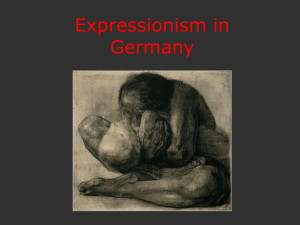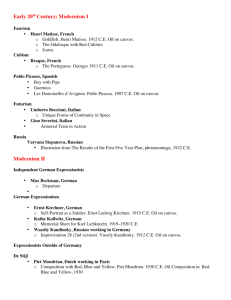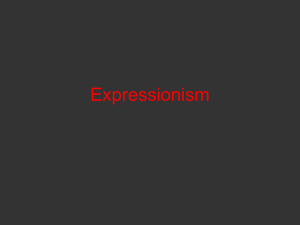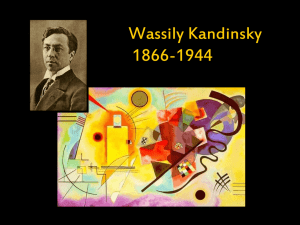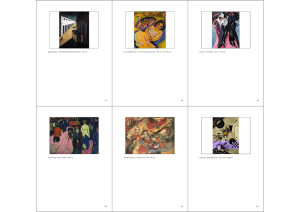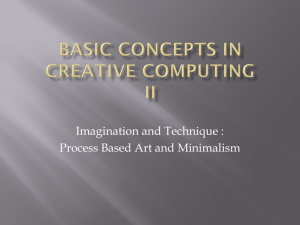Expressionism in Germany
advertisement
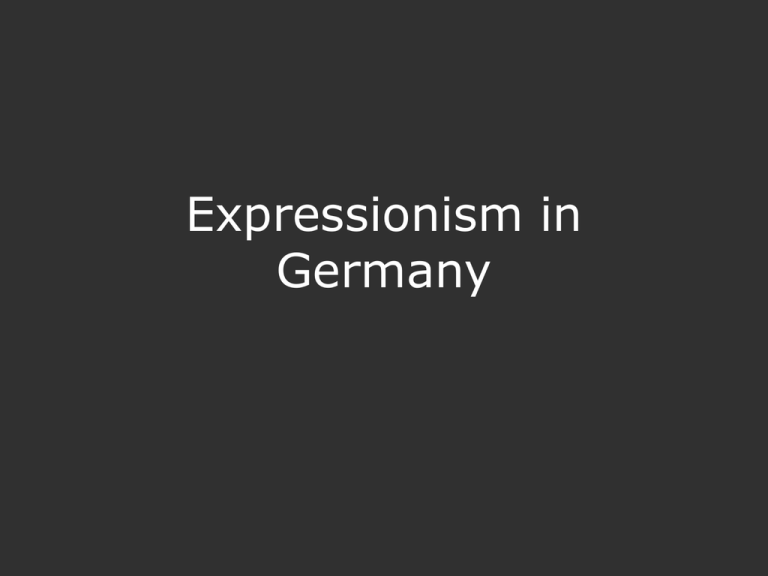
Expressionism in Germany Paula Modersohn-Becker (German, 1876-1907: 31 years) from Post-Impressionism to ProtoExpressionism Self Portrait, 1907, 62 × 31 cm (left) Otto Modersohn, Moor Grasses, 1895 (right) Paula Modersohn-Becker, Red House, 1900 Worpswede, a rural German village and artist colony Paula Modersohn-Becker (left) with sculptor Clara Westhoff Becker spent 6 months in Paris 1900 where Westhoff was studying with Auguste Rodin and attending the Academie Colarossi (right) Modersohn-Becker, Rainer Maria Rilke, 1906 Paula Modersohn-Becker (right), Self Portrait on Her Sixth Wedding Day, 1906, oil on board, 101 cm H, Bremen. (left) Self-Portrait with Amber Necklace, 1906. During the artist’s last, 1906 stay in Paris she painted a series of nude self portraits, unprecedented by a woman artist and considered the most historically significant works of her short career. Paula Modersohn-Becker, Self-Portrait with Amber Necklace (left), 1906 Paul Gauguin, Woman with a Mango (right), 1892 Modersohn-Becker, Reclining Mother and Child, 1906 (lower right) Paul Gauguin, Nevermore, 1897 (left) William Bouguereau, Madonna and Child with Saint John the Baptist c. 1890. (right) Paula Modersohn-Becker, Reclining Mother and Child, 1906 Edvard Munch Madonna, lithograph 1895 Käthe Kollwitz (German 1867-1945), Self Portrait and Nude Studies, 1900, graphite, pen and black ink. 280 x 445 cm. Stuttgart Käthe Kollwitz, Charge, etching, drypoint, aquatint, and softground, 1902/03. From Kollwitz’s series, The Peasant War, inspired by the violent revolution which took place in Germany beginning in 1525. The artist identified with Black Anna, an instigator of the revolt. "I have never produced anything cold, but always to some extent with my blood." Käthe Kollwitz (German 1867-1945), Woman with Dead child, 1903, etching with engraving overprinted with a gold tone plate, 47.6 x 41.9 cm Paula Modersohn-Becker (German 1876-1907), Reclining Mother and Child, oil on canvas, 124.7 x 82 cm. 1906 (right) The maternal nude is a new subject in the history of Western art introduced by women artists to tell of a woman’s experience of body and life. Käthe Kollwitz, The Volunteers, 1924, woodcut. Part of the War Cycle Käthe Kollwitz, Mothers (left), 1924; (right) Nie Wieder Kreig! (No More War!), litho poster for the Social Democratic Party, 1924 Käthe Kollwitz, Death Seizing a Woman,1934, from the series Death, 193436, lithograph printed in black, 20 x 15” MoMA NYC (right) Self Portrait, 1934, lithograph. In 1933 the Nazis made it illegal to display Kollwitz’s art and confiscated it, declaring "In the Third Reich mothers have no need to defend their children. The State does that.“ Kollwitz, the first woman elected to the Prussian Academy of Art in Berlin, was expelled. Wassily Kandinsky (Russian 1866-1944) The artist is not born to a life of pleasure. He must not live idle; he has a hard work to perform, and one which often proves a cross to be borne. He must realize that his every deed, feeling, and thought are raw but sure material from which his work is to arise, that he is free in art but not in life....The artist is not only a king...because he has great power, but also because he has great duties. Wassily Kandinsky, "Conclusion" Concerning the Spiritual in Art, 1912 Kandinsky developed his theory and practice of abstract expressionist art between 1908 - 1911: three years. Wassily Kandinsky, The Blue Rider, oil on cardboard, 1903 Claude Monet, Haystack (Winter), 1891 The Blue Rider as symbol of the artist will recur and evolve according to the principles he defines in his theoretical essays, Concerning the Spiritual in Art and The Blue Rider Almanac. (left) Wassily Kandinsky, The Blue Mountain, 1908, o/c (right) Henri Matisse, The Joy of Life, 1906 Kandinsy’s Fauvist (style) symbolist landscapes (right) Annie Besant and Charles Leadbeater (Theosophist), ThoughtForm: Music of Wagner 1905, (left) Kandinsky, Mountain, 1908 Towards abstract painting (left) Wassily Kandinsky, Murnau: View with Railroad and Castle, 1909, oil on cardboard Kandinsky, Church in Murnau, 1910, Oil on cardboard Towards abstraction: tracking Kandinsky’s visual thinking Wassily Kandinsky, Study for Composition 2, 1909-10, o/c, 38 x 51” Guggenheim, NYC. Based on Bible stories of the Deluge (Genesis) and Apocalypse (Revelations) Wassily Kandinsky, 1911, Composition IV, o/c objective forms are “veiled” and “dissolved” "I more or less dissolved the objects so that they could not all be recognized at once, and so that their psychic sounds could be experienced one after the other by the observer." Wassily Kandinsky, Composition 7, 1913, o/c, 6’6” x 9’11” "Generally speaking, color is a power which directly influences the soul. Color is the keyboard, the eyes are the hammers, the soul is the piano with many strings. The artist is the hand which plays, touching one key or another, to cause vibrations in the soul." Kandinsky (left) Kandinsky, Cover of Der Blaue Reiter (The Blue Rider) Almanac, woodcut, 1912 (right) Kandinsky, Cover of Concerning the Spiritual in Art, 1912 "Then I saw heaven opened, and behold, a white horse! He who sat upon it is called Faithful and True and in righteousness he judges and makes war. He is clad in a white robe dipped in blood." Revelations Die Brücke (The Bridge) Dresden Germany (left) Ernst Ludwig Kirchner (German, 1880-1938), The Painters of Die Brucke, 1925, o/c (L to R: Otto Muller, Ernst Ludwig Kirchner, Erich Heckel, Karl Schmidt-Rottluff (right) Manifesto of the Artists’ Group the Brücke, woodcuts “With faith in progress and in a new generation of creators and spectators we call together all youth. As youth, we carry the future and want to create for ourselves freedom of life and of movement against the long established older forces. Everyone who reproduces that which drives him to creation with directness and authenticity belongs to us." (left) Ernst Ludwig Kirchner, Girl With Japanese Parasol, 36 x 31 inches, oil on canvas, 1909 (Die Brücke, German Expresssionism) (right) Henri Matisse, Blue Nude: Souvenir of Biskra, o/c, 36 x 55 inches, 1907 (Fauve, French Expressionism) How is “expression” differently defined by these artists? (left) Ernst Ludwig Kirchner, The Street, 1907, 59" x 6' 7“, o/c, MoMA NYC (right) Kirchner, Potsdamer Platz, 1914, o/c, 78 x 59”, National Gallery, Berlin Influence of Munch, Van Gogh, Gauguin, and Matisse Ernst Ludwig Kirchner, Dancing Woman, 1911, wood polychromed (center) André Derain (French Fauve painter and sculptor, 1880-1954) Crouching Man, 1907, stone, 13 x 11” (right) Paul Gauguin, Idol, 1892, wood polychromed Expressionist Primitivism – French and German (left) Ernst Ludwig Kirchner, Self-Portrait as a Soldier, 1915 (right) Kirchner, The Soldier Bath (Artillerymen), 1915, oil on canvas, 55 x 59 inches Emil Nolde (German, 1867-1956) , The Last Supper, 33 x 42” oil, 1909 No image of nature was near me, and now I was to paint the most mysterious, the profoundest, most inward event of all Christian religion! . . . I painted and painted, hardly knowing whether it was night or day, whether I was a human being or only a painter. Emil Nolde, Jahre der Kämpfe, 1902-14 Emil Nolde, Christ and the Children, 1910 (left) Emil Nolde, Dance around the Golden Calf, 1910, oil on canvas, 88 x 105 cm, with detail, below. Visited German New Guinea in 1913. (right) Nolde, Prophet, 1912, woodcut. Detail of Dance, showing gestural, impasto application of paint Egon Schiele (Austrian 1890-1918), Self-Portraits, 1911 Egon Schiele (Austrian 1890 -1918), Danae, 1909, Oil and metal on canvas (right) Gustave Klimt (Austrian 1862 - 1918), Death and Life, 1908-9 Egon Schiele, Cardinal and Nun, 1912 Egon Schiele, The Self Seers (Death and the Man), 1911, oil, 31 x 31” Oskar Kokoschka (Austrian 1886-1980) (left) Self-Portrait (Der Sturm, Berlin), 1910 Kokoschka (center and right), Murder, Hope of Women, 1909, poster and drawing for his play. First Expressionist play performed in Vienna, intended as blasphemy; OK called it a "gesture of defiance” meant to break down conventions of bourgeois society. Oskar Kokoschka, Portrait of Adolf Loos, 1909, oil, 29 x 36”, Berlin (left) Vincent Van Gogh, Père Tanguy, 1888 (center) Käthe Kollwitz, Lamentation: In Memory of Ernst Barlach (Grief), bronze, 1938 (right) Oskar Kokoschka, Adolf Loos, 1909 Compare the “expressionism” of Henri Matisse: “Expression. . . does not consist of the passion mirrored upon a human face or betrayed by a violent gesture.” Matisse, Notes of a Painter, 1908 Matisse, The Dance, 1909 (left); Kokoschka, Portrait of Adolf Loos, 1909 (right) (left) Max Beckmann (German 1884 – 1950), Self Portrait with Raised Hand, 1907 / among 85 self-portraits (center) Beckmann, Self Portrait as Medical Orderly, 1915 (right) Beckmann, Self Portrait with Red Scarf, 1917 1907 1915 1917 Europe during and after World War I: 1914 (left) and 1919 (right) (left) Max Beckmann, Descent From the Cross, 1917 (right) Rogier Van Der Weyden (Netherlandish Northern Renaissance Painter, ca.1400-1464) Descent From the Cross, c. 1435 Max Beckmann, The Night, 1918-19, oil on canvas Gothic cathedral relief showing the damned: claustrophobic compression shallow, frontal staging of Beckmann’s Night and oeuvre. Matthias Grünewald (German, c. 1480 - 1528) Isenheim Altarpiece (closed) , c. 1510-15 triptych, standard format for Christian altar paintings Max Beckmann, Departure, 1932-33, oil on canvas, triptych center panel 7' 3/4" x 45 3/8“, MoMA NYC Beckmann called the center panel "The Homecoming“: "The Queen carries the greatest treasure - Freedom - as her child in her lap. Freedom is the one thing that matters. It is the departure, the new start." Otto Dix (German Expressionist, 1891-1969), Self Portraits as Soldier, 1914 Otto Dix, from print series, Der Krieg (War), etching with aquatint, 1924 (left) Mealtime in the Trenches, and (right) Skin Graft Otto Dix, Triptychon der Krieg (War Triptych), oil, 1929-1932, Dresden George Grosz (German 1893-1959) (left) Grey Day, 1921, oil on canvas (right) Grosz, Fit for Active Service (The Faith Healers), 1916-17, pen, brush, ink on paper, 20 x 14”, MoMA NYC. The artist is associated with New Objectivity and Berlin Dada movements but can be called a German Expressionist. Otto Dix, The Skat Players – Card Pyaying War Invalids, 1920, oil and collage on canvas, 43x34”, Staatliche Museen zu Berlin August Sander (German, New Objectivity, 1876-1964), Brick Carrier (left), and Cook (right) 1928, from the Face of Time portfolio. Sander was enormously influential on 20th century photographers August Sander, Circus People from the portfolio, Citizens of the 20th Century, 1930 Albert Renger-Patzsch (German 1897 – 1966), New Objectivity Irons Used in Shoemaking, Fagus Works, c. 1925 (left) and Foxgloves, c. 1925 (right) Hitler and Goebbels at the Degenerate Art (Entartete Kunst) exhibition exhibit, featuring over 650 paintings, sculptures, prints, and books from the collections of thirty two German museums, premiered in Munich on July 19, 1937 and remained on view until November 30 before travelling to eleven other cities in Germany and Austria. “Good German Art” admired and supported by the National Socialist (Nazi) Party (left) Nazi artist, Ivo Saliger, Judgment of Paris, oil on canvas, Arno Becker, Predestination, 1938 (right) Adolph Hitler (German 1889 – 1945), Landscape, 1925
